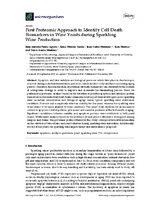First Proteomic Approach to Identify Cell Death Biomarkers in Wine Yeasts during Sparkling Wine Production
Autor
Porras-Agüera, Juan Antonio
Moreno-García, Jaime
Mauricio, Juan C.
Moreno, Juan
García-Martínez, Teresa
Editor
MDPIFecha
2019Materia
ApoptosisAutolysis
Proteome
Yeast
Sparkling wine
CO2 overpressure
METS:
Mostrar el registro METSPREMIS:
Mostrar el registro PREMISMetadatos
Mostrar el registro completo del ítemResumen
Apoptosis and later autolysis are biological processes which take place in Saccharomyces cerevisiae during industrial fermentation processes, which involve costly and time-consuming aging periods. Therefore, the identification of potential cell death biomarkers can contribute to the creation of a long-term strategy in order to improve and accelerate the winemaking process. Here, we performed a proteomic analysis based on the detection of possible apoptosis and autolysis protein biomarkers in two industrial yeast strains commonly used in post-fermentative processes (sparkling wine secondary fermentation and biological aging) under typical sparkling wine elaboration conditions. Pressure had a negatively effect on viability for flor yeast, whereas the sparkling wine strain seems to be more adapted to these conditions. Flor yeast strain experienced an increase in content of apoptosis-related proteins, glucanases and vacuolar proteases at the first month of aging. Significant correlations between viability and apoptosis proteins were established in both yeast strains. Multivariate analysis based on the proteome of each process allowed to distinguish among samples and strains. The proteomic profile obtained in this study could provide useful information on the selection of wine strains and yeast behavior during sparkling wine elaboration. Additionally, the use of flor yeasts for sparkling wine improvement and elaboration is proposed.

